mercy. liberia. november.
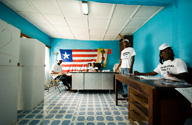
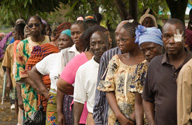
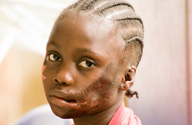
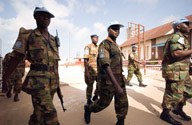
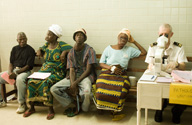
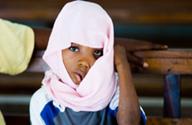
mercy.
November 13, 2005
The past two weeks in Liberia have passed like months. I've photographed the nation's first elections after more than 14 years of brutal civil war, escaped a riot as angry protesters met UN peacekeepers and tear gas, and of course, did what I came back to Africa to do - documented hundreds of patients scheduled for free surgery onboard our hospital ship.
Liberia treads gingerly towards a future of peace and promise. The pot-holed streets of Monrovia host voters who speak about hope yet seem doubtful. The Ak-47's on the more than 15,000 United Nations troops swing at attention as tanks roll visibly and loudly down Broad Street. Sirens wail and armored convoys are a dime a dozen. And, as I'm writing this, it seems Liberians have elected Africa's first woman president. Ever.
A week ago it looked like a soccer player would be the country's first president after the long war, yet today with 97 percent of precincts reporting, a woman, Harvard grad World Bank ex Ellen Johnson-Sirleaf has an insurmountable 18 point lead. But African politics are never simple. George Weah has cried foul and his supporters have taken to the streets in protest. No Weah, No Peace! they chant, hurling rocks. It's doubtful anyone will listen. I observed the elections firsthand, traveling to ten Monrovia polling stations, and was impressed at the meticulous order and fairness of the process.
But days before hundreds of thousands of voters stood in line at the polls, a different line formed outside a Monrovia hospital to meet our Mercy Ship surgeons. A line formed of the sick and desperate - those to whom politics took a back burner. Some fought just to stay alive in a country with almost no access to healthcare, where one doctor serves 50,000. They waited in early morning heat as I sprung out of bed at 4:26 and drove to the hospital to begin screening day.
My job again was to photograph the patients we book for surgery. Between white sheets haphazardly strung on rope, my little portrait station was the second to last stop, and a feel good gig. Unlike many of the earlier stations, where doctors have to gently turn away those whose are inoperable or untreatable, if they reach me they've passed the emotional gauntlet of more than 10 doctors, nurses and surgeons, and are cleared for surgery. They've passed the test of needles, tongue depressors and blood pressure cuffs.
They come to me with hope. Hope that their benign tumor might now not suffocate or starve them to death. That years of scorn and dirty looks thrown their way as a result of their cleft lip might vanish in an hour-long operation. That their sight might be restored again after a surgeon sucks cataracts out with machines in a 20-minute operation.
---
Back in NY, as I finished hanging the mercy exhibition at the Metropolitan Pavilion Gallery in Chelsea, I realized I didn't have enough moving images. The stills and storyboards didn't seem to do justice to the people I'd come face to face with. I knew our patients in motion. As living breathing humans - heroes who had suffered much and survived. Heroes snorting food through noses to stay alive as tumors blocked their mouths. Heroes who had never lost grip of hope, praying with unwavering faith for salvation.
Warhol made an eight-hour silent film in the 60's, where he showed only a man sleeping. It was interesting and disturbing. With that in mind, after photographing the patients, I decided to ask some of them to tell their stories on camera without using words. I asked them to simply look into the camera and left the station, hoping to capture on video what it was really like to be them. To live inside their skin. Back in my office later, I wept, watching the footage.
There was something so singular and direct about the message. For me, I'd recently been overwhelmed with the sheer numbers and hopelessness surrounding me - an even poorer mass of humanity seemed to inhabit Monrovia. So many poor, so many sick with no access to healthcare. By mid-afternoon at screening, I had wondered what was wrong with me. I wasn't struggling to fight back tears this time around. Was this what happened to humanitarian workers? Was I becoming numb? Lost in the numbers? Was it time to throw my hands up in the air and go home?
Yet watching the footage, the message hit me. Without words, the individuals seemed to scream out, "I am a child of God - do something." It was an appeal, and it made me squirm.
It's easy to shut down when viewing a graphic photo. Some of the images I capture seem so disconnected from reality. But watching the deformed lick their lips in close-up, watching eyes dart back and forth as if looking to escape from tormentors, I connected again.
And this time, it was on a spiritual level.
As many of you know, Mercy Ships is a faith-based organization. The surgeries done onboard the ship are modern-day answers to miraculous events in Bible times. The lame walk through orthopedic operations, the blind see when cataracts are removed, the mute speak when tumors meet scalpels and cleft lips are closed.
Back home, it's so easy to discredit Christianity and the Bible because of so many who simply don't walk the talk and have swapped love for judgement - but here, seeing the teachings of Christ and altruistic love in action... it makes so much sense to me.
To me, Jesus was all about the one. And He was all about extremes. Whether it was a lost sheep or hooker, he desperately sought out the marginalized and insisted on making them whole. He went after drunks and corrupt taxmen and delighted in transforming their lives. And the work was important. Neighbors were roused and a party thrown when a mangy sheep was found. A feast and fine clothes appeared for a prodigal son who limped home after years of debauchery.
---
Towards the end of screening day, I met Hawa.
She was a beautiful seven-year-old girl from Sierra Leone, and was being choked to death by a fast-growing benign tumor. Five people came over to my photo station wide-eyed, asking whether I'd seen her before I finally went in search of her. I found her by the pathology station waiting for the moment of truth. Was the tumor benign? Could we operate?
The answer was yes, and I photographed her an hour later.
Only a few weeks into a long outreach where we'll do thousands of procedures, Hawa is a beautiful reminder for me of God's love for "the one." Her sad story is not so different than many, and a loving father carried her two days and across a border for a last hope at her life.
Photographing her surgery, and getting to know her on the ship's ward has been a real reminder of why I came back to the ship, back to Africa. And I really do love the crazy idea, that if all 350 of us crew jumped on planes just to save little Hawa from her suffering and certain premature death, it would be worth it. Somehow that would be ok.
It doesn't work for me on a practical level, in a world where millions are vaccinated for pennies, but I catch a glimpse of the Creator's heart and love for a little girl every time I see her smile.
-----------------------------------------
To view a small sample of the video footage I shot at patient screening, please click here.
To meet Hawa, click here.
If you'd like to help financially support the work of mercy ships, drop me a line: scott@onamercyship.com or go here
